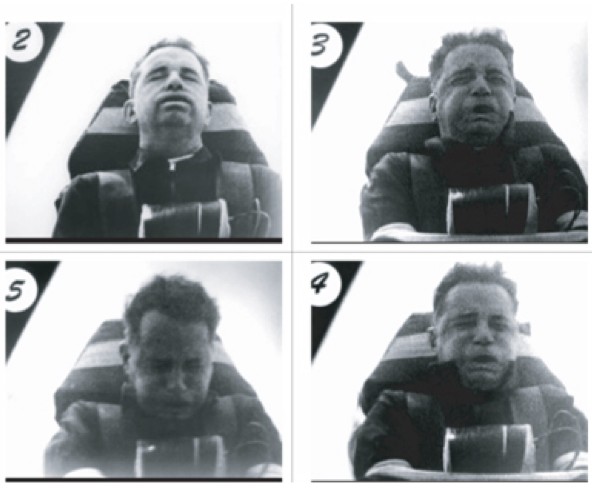Physicist: The existence of Santa Claus is an established fact, beyond debate. I, like most people of my generation, have verified his existence experimentally by means of the “Cookie test”.
The idea that millions of people, the world over, could leave cookies and milk out in the evening, and have them replaced by presents in the morning, without a “Jolly Agent” implies a conspiracy on a frankly Orwellian scale. That “theory” can be dismissed out of hand. Occam’s razor alone shows that this is essentially an open and shut case.
NORAD (originally “CONAD”) has publicly tracked Santa’s sleigh since 1955. According to A. Grawert, Esq. of Anonymous Law Firm LLP, although the consent of NORAD isn’t proof, it does provide a legal basis for his existence, as established in the landmark 1937 case “The People of the State of New York v. Kringle” (N.Y. Sup. Ct. 1937).
There is however a paranoid sub-culture of conspiracy theorists that quietly advocate the non-existence of Santa Claus (“asantists”). So, for the rest of us, what follows is a look at some of the surprises of Cheer-based Gift-Delivery physics.
There are approximately 2 billion children in the world. Assuming that there are 2 children per household and that the naughty and nice lists are the same length, then that leaves approximately 750 million households for St. Nick to visit. Before the 24th, Santa’s Elves make toys and solve the Traveling Salesman Problem to plot the delivery route (Holiday magic and quantum computers are some of the only known methods for solving NP problems). For a random arrangement of N points contained in a reasonably shaped, finite area, A, you can estimate the length of the optimal solution. The length, L, is approximately , and the average distance between houses is
.
Plugging in the non-Antarctic land area of the Earth (A=136,000,000 km2) and the number of Nice-list homes (N=1,500,000) yields L=200 million km and d=0.3 km. Assuming that Santa covers the full distance in 24 hours, and spends half the time flying and half the time gifting and eating, he’d have an average speed of around 17,000,000 kph (or about mach 14,000), which is far less than the speed of light, and is totally doable. He’d have to experience an acceleration somewhere in the ballpark of 30 billion g’s, on and off, for 12 hours, but again, that’s doable.
Even using so-called “conventional science” a human being can survive as much as 15 g’s when suspended in a fluid. The highest acceleration survived by a human (a human named Col. John Stapp) is 46 g’s, and he was blind for barely a day. But, keep in mind that rather than being a grouchy young human, Santa is in fact a jolly old elf.
It could be that what we think of as a “bowl full of jelly” may very well be an “elfin g-suit” that Santa uses to overcome the stresses of the journey. The only way to say for sure is to ask him. But, I’ve found empirically that almost every Santa you’ll meet is, in fact, an asantist impostor.
Traveling with an average speed of 17 million kph means that the back of Santa’s sleigh is in a hard vacuum. More than that, the heat energy generated by Santa’s trip totals about 2 x 1015 tons of TNT equivalent, or about 40,000 metric tons of anti-matter (and 40,000 matching tons of ordinary matter). “Conventional” physicists would say that the surface of the Earth would be completely vaporized by this joyous and welcome yearly Yule Tide. What they don’t take into account is jingle-Bell’s theorem of quantum christmas, and a generous helping of X-mas miracles!
It would take about 5,000,000 Santa’s (or about 1022 tons of TNT) to completely destroy (disassemble) the Earth. 2 x 1015 tons of TNT would just throw the top half mile or so into space. Happy holidays!
Update: Some concerned readers pointed out that the “# of naughty = # of nice” estimate may involve more optimism than is entirely warranted.
Which raises the question: given that Santa exists, and so does life on Earth, how many nice children can there be? I bet a 1°C increase in the world temperature could be small enough to go unnoticed. So (using the same estimates to back solve), if Santa’s break-neck course only released enough energy to cook the Earth by 1°C, then there can be no more than around 4,000 nice-households in the world.
It would seem that we can safely say that 99.9997% of children should have watched out, they shouldn’t have cried, they shouldn’t have pouted, and we can derive why.









LOVE IT! 😀 Merry Christmas!
There’s also a logical proof of Santa’s existence.
Suppose we’ve got some truth about Santa. Like: Santa lives at the north pole. Or: Santa is a fictional character. Or: Santa is distinct from the number 7. In symbolising one of these sentences, we can use ‘s’ as a constant to refer to Santa:
1. F(s).
2. For all x, x=x.
3. So, s=s.
4. So, there exists an x such that x=s.
Merry Christmas, Physicist and Mathematician! I miss you!
QED ∀, and ∀ a good night! Miss you too.
Pingback: Q: Can we build a planet? « Ask a Mathematician / Ask a Physicist
maybe he just uses teleport to solve the travel and chimney problems
What is Santa’s coefficient of friction, and what altitude is he flying at? These factors, among other atmospheric conditions would change the amount of heat generated by the jolly one.
I assumed a white Christmas, and that he was flying near ground level, because sometimes (not often) he’d have to visit different houses on the same street. I’m going to have to go back and check my notes to find the drag coefficient.
You forgot to take relativistic time dilation (the Lorentz coordinate transform) into account. At high speeds, Santa’s local time slows down, quite possibly enough to allow him to go back in time, on a house-by-house basis, giving him plenty of time to visit every “nice” house.
Turns out it’s not too important.
Santa’s average speed (when working) is about 1.5% of light speed. So while the rest of the world experiences 24 hours of sugar plums and cheer, Santa experiences only 23 hours, 59 minutes, and 49 seconds (give or take).
The number of children can be further decreased by taking into account those children whose families do not celebrate Christmas.
Santa is fake because: If santa= x and yXy=x x<0 then
Square root of x (Santa) is i (imaginary number) times y then Santa clause does not exist because IMAGINARY NUMBERS ARE NOT REAL NUMBERS !!!!
In FORTRAN II, SANTA is real, as are all the reindeer whose names have 6 or fewer characters. KRIS (as in Kringle), however, is an INTEGER.
EVERYONE knows that using AND multiplying by the factorial value of infinity gives Santa his REAL santa magic in these calculations and when applied to time this makes time elastic…and if mere humans could learn to harness this clean energy power … especially Moms we would be so much more efficient but THAT is why it is called magic!
SANTA IS REAL DON’T RUIN PEOPLES DREAMS